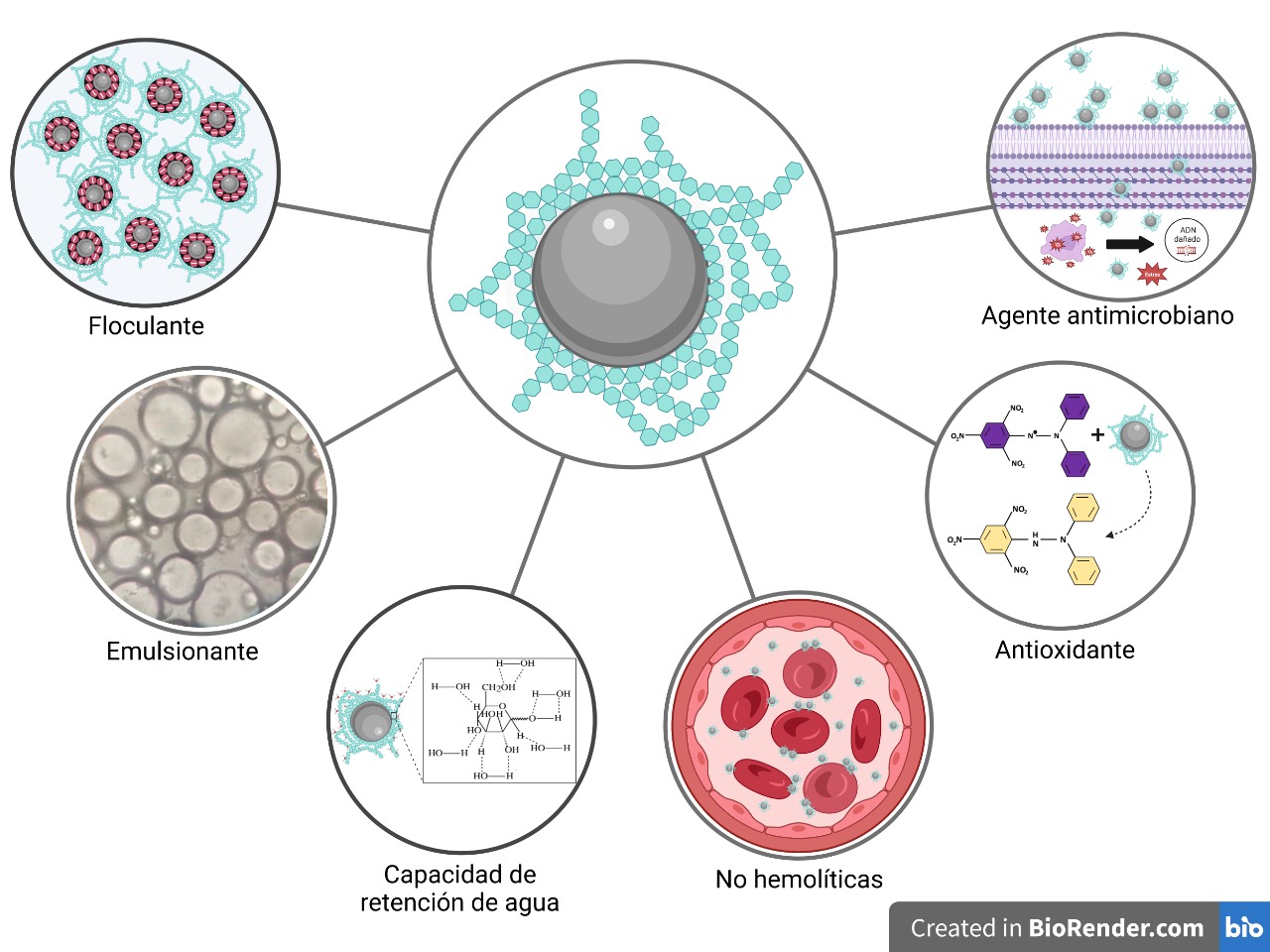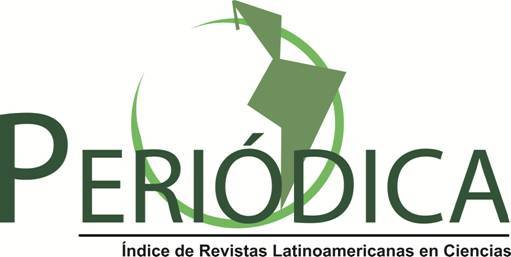Structural and functional characterization of ZnO-EPS nanoparticles synthesized from exopolysaccharides produced by Lactiplantibacillus fabifermentans BAL-27-ITTG
ZnO-EPS nanoparticles
DOI:
https://doi.org/10.18633/biotecnia.v25i3.1950Keywords:
Nanoparticles, microparticles, ZnO, exopolysaccharides, Lactiplantibacillus fabifermentansAbstract
Exopolysaccharides (EPS) can be used as reducing agents and stabilizers improving the physical and chemical properties of metallic nanoparticles. This study aimed to synthesize and evaluate the physicochemical, structural, and functional characteristics of ZnO particles obtained from EPS produced by Lactiplantibacillus fabifermentans BAL-27-ITTG. The structural characterization of the EPS exhibited a high molecular weight structure composed mainly of mannose and glucose possibly linked by α-1-4, α-1-3, α-1-6 according to the RMN spectrum. The increase in the concentration of EPS during the synthesis leads to an increase of particle size at micrometric scale decreasing the polydispersity index. The synthesis was confirmed with a UV-vis spectral scan, while the FT-IR spectrum showed absorption peaks at 600 cm-1 associated with the Zn-O bond. Synthetized nano and microparticles showed improved functional characteristics comparing to free EPS. The highest values of antioxidant activity (80.25 %), water holding capacity (3.06 g H2O/ g sample), emulsifying activity (69.85 %) and flocculant activity (69.07 %) were obtained from MpZnO-EPS synthetized with a concentration of 6 mg/mL of the reducing agent. Bacteriostatic activity was observed against Staphylococcus aureus and Lactiplantibacillus fabifermentans. The biocompatibility assay confirmed the obtention of non-hemolytic particles.
Downloads
References
Abinaya, M., Vaseeharan, B., Divya, M., Sharmili, A., Govindarajan, M., Alharbi, N. y Benelli, G. 2018. Bacterial exopolysaccharide (EPS)-coated ZnO nanoparticles showed high antibiofilm activity and larvicidal toxicity against malaria and zika virus vectors. Journal of Trace Elements in Medicine and Biology. 45: 93-103. doi.org/10.1016/j.jtemb.2017.10.002.
Adesulu-Dahunsi, A., Kumaraswamy, J. y Sanni, A. 2018. Production of exopolysaccharide by strains of Lactobacillus plantarum YO175 and OF101 isolated from traditional fermented cereal beverage. PeerJ Publishing. 6-10. doi: 10.7717/peerj.5326.
Alvarado, V. 2015. Evaluación del exopolisacárido producido por una bacteria psicrotolerante aislada del noreste de México y sus potenciales aplicaciones industriales. [Tesis de maestría, Universidad Au-tónoma de Nuevo León]. http://eprints.uanl.mx/id/eprint/9408.
Ates, O. 2015. Systems Biology of Microbial Exopolysaccharides Production. Frontiers in Bioengi-neering and Biotechnology. 3: 200. doi: 10.3389/fbioe.2015.00200.
Azim, A., Atta, A. y Khedr, M. 2018. Determination of intrinsic viscosity of polymeric compounds through a single specific viscosity measurement. Polymer. 39(26): 6827-6833. doi:10.1016/S0032- 3861(98)00184-0.
Aziz, A., Shaniba, V. y Jayasree, P. 2020. Physico-chemical, photocatalytic and cytotoxicity evaluation of Annona muricata L. fruit extract derived zinc oxide nanoparticles in comparison to the commercial chemical versión. Current Science. 117(9): 1492-1504. doi: 10.18520/cs/v117/i9/1492- 1504.
Bajpai, V., Kamle, M. y Sukla, S. 2018. Prospects of using nanotechnology for food preservation, safety, and security. Journal of Food and Drug Analysis. 26(4): 1201-1214. doi.org/10.1016/j.jfda.2018.06.011.
Busi, S., Karuganti, S. y Pattnaik, S. 2016. Sludge settling and algal flocculating activity of extracellular polymeric substance (EPS) derived from Bacillus cereus SK. Water and Environment Journal. 31(1): 97- 104. https://doi.org/10.1111/wej.12215.
Chapot-Chartier, M. y Kulakauskas, S. 2014. Cell wall structure and function in lactic acid bacteria. Microbial Cell Factories. 13(1): S9. doi: 10.1186/1475-2859-13-S1-S9.
De Freitas, R. A., Nicolai, T., Chassenieux, C. y Benyahia, L. 2016. Stabilization of water-in-water emulsions by polysaccharide-coated protein particles. Langmuir. 32(5): 1227-1232. https://doi.org/10.1021/acs.langmuir.5b03761.
Dlamini, N., Basson, A. y Pullabhotla, V. 2019. Optimization and application of bioflocculant passivated copper nanoparticles in the wastewater treatment. International Journal of Environmental Research and Public Health. 16(12): 2185. https://doi.org/10.3390%2Fijerph16122185.
Estudillo-Diaz, E.B., Gutiérrez-Miceli, F.A., González-Mendoza, D., Valdez-Salas, B., y Abud-Archila, M. 2022. Desarrollo y caracterización de películas activas con nanopartículas de plata obtenidas mediante síntesis verde. Biotecnia, 25(1): 109–115. https://doi.org/10.18633/biotecnia.v25i1.1683.
Gutiérrez-Sarmiento, W., Ventura-Canseco, L. M. C., Gutiérrez-Miceli, F., Luján-Hidalgo, M. C., Ab-ud-Archila, M. y Ruíz-Valdiviezo, V. 2020. Optimization of biomass production, lactic acid, and gastrointestinal simulation survival of Lactobacillus plantarum BAL-03-ITTG cultured in stirred tank bioreactor. Agrociencia. 54:147-162.
Guo, M.Q., Hu, X., Wang, C., y Ai, L. 2017. Polysaccharides: Structure and Solubility. Solubility of Polysaccharides. doi: 10.5772/intechopen.71570.
Hayat, S., Ashraf, S., Zubair, M., Aslam B. y Muzammil. 2022. Biofabrication of ZnO nanoparticles using Acacia arabica leaf extract and their antibiofilm and antioxidant potential against foodborne pathogens. Plos One. 17(1): e0259190. https://doi.org/10.1371/journal.pone.0259190.
Ismail, B. y Nampoothiri, K. 2014. Molecular characterization of an exopolysaccharide from a probiotic Lactobacillus plantarum MTCC 9510 and its efficacy to improve the texture of starchy food. Journal of Food Science and Technology. 51(12): 4012-8. https://doi.org/10.1007/s13197-013-0928-8.
Jay-Chithra, M., Sathya, M. y Pushpanathan, K. 2015. Effect of pH on crystal size and photolumines-cence property of ZnO nanoparticles prepared by chemical precipitation method. Acta Metallurgica Sinica, 28(3): 394–404. doi: 10.1007/s40195-015-0218-8.
Jayachandran, A. y Nair, A. 2021. Green synthesis and characterization of zinc oxide nanoparticles using Cayratia pedata leaf extract. Biochemistry and Biophysics Reports. 26. https://doi.org/10.1016/j.bbrep.2021.100995.
Jayawardena, B., Pandithavidana, D. y Sameera, W. 2017. Polysaccharides in solution: experimental and computational studies. INTECH. 4. doi: 10.5772/intechopen.69863.
Jiang, G., Gan, L., Li, X. y Tian, Y. 2021. Characterization of structural and physicochemical properties of an exopolysaccharide produced by Enterococcus sp. F2 from fermented soya beans. Frontiers in Microbiology. 12:744007. doi: 10.3389/fmicb.2021.744007.
Jin, J., Yang, Z., Xiong, W., Zhou, Y., Xu, R., Zhang, Y. y Zhou, C. 2019. Cu and Co nanoparticles co-doped MIL-101 as a novel adsorbent for efficient removal of tetracycline from aqueous solu-tions. Science of the Total Environment. 650(1): 408-418. https://doi.org/10.1016/j.scitotenv.2018.08.434.
Jo, D.H, Kim, J., Lee, T. y Kim, J. 2015. Size, surface charge, and shape determine therapeutic effects of nanoparticles on brain and retinal diseases. Nanomedicine. 11(7): 1603-1611. doi: 10.1016/j.nano.2015.04.015.
Jurasková, D., Riveiro, S. y Silva, G. 2021. Exopolysaccharides produced by Lactic acid bacteria: from biosynthesis to health-promoting properties. Foods. 11(2):156. https://doi.org/10.3390/foods11020156.
Kavitake, D., Balyan, S. y Devi, P. 2020. Evaluation of oil-in-water (O/W) emulsifying properties of galactan exopolysaccharide from Weissella confusa KR780676. Journal of Food Science and Technology. 57(4): 1579-1585. https://doi.org/10.1007/s13197-020-04262-3.
Khan, S., Jabeen, F., Qureshi, A., Asghar, S. y Noureen, A. 2015. Toxicity of silver nanoparticles in fish: a critical review. Journal of Biodiversity and Environmental Sciences. 6(5): 211-227. https://www.researchgate.net/publication/280686023.
Leonia, M., Menezes, T., Souza, J. y Nágila, R. 2013. Structural characterization of β glucans isolated from Agaricus blazei murill using NMR and FTIR spectroscopy. Bioactive carbohydrates and die-tary fibre. 152-156. https://doi.org/10.1016/j.bcdf.2013.10.005.
Li, S., Huang, R., Shah, N. y Tao, X. 2014. Antioxidant and antibacterial activities of exopolysaccharides from Bifidobacterium bifidum WBIN03 and Lactobacillus plantarum R315. Journal of Dairy Sci-ence. 97(12): 7334-7343. https://doi.org/10.3168/jds.2014-7912.
Li, H., Wu, S., Du, C. y Zhong, Y. 2020. Preparation, performances, and mechanisms of microbial flocculants for wastewater treatment. International Journal of Environmental Research and Public Health, 17(4):1360. doi: 10.3390/ijerph17041360.
Lim, J., Yeap, S., Che, H. y Low, S. 2013. Characterization of magnetic nanoparticle by dynamic light scattering. Nanoscale Research Letters. 8: 381 http://www.nanoscalereslett.com/content/8/1/381.
Mahamuni, P., Patil, P. y Bohara, A. 2019. Synthesis and characterization of zinc oxide nanoparticles by using polyol chemistry for their antimicrobial and antibiofilm activity. Biochemistry and Biophysics Reports. 17: 71-80. https://doi.org/10.1016/j.bbrep.2018.11.007.
Murru, C. 2021. Potencial tecnológico de los puntos cuánticos de carbono antioxidantes: el impulso hacia metodologías verdes y nanotecnología sostenible. Tesis doctoral, Universidad de Oviedo España.
Njus, D., Kelley, P.M., Tu, Y.J. y Schlegel, H.B. 2020. Ascorbic acid: The chemistry underlying its antioxidant properties. Free Radical Biology and Medicine. 159: 37-43. https://doi.org/10.1016/j.freeradbiomed.2020.07.013.
Salunke, G., Gosh, S., Kumar, R., Khade, S. y Kale, T. 2014. Rapid efficient synthesis and characteri-zation of silver, gold, and bimetallic nanoparticles from the medicinal plant plumbago zeylanica and their application in biofilm control. International Journal of Nanomedicine. 9: 2635-53. doi: 10.2147/IJN.S59834.
Sathiyanarayanan, G., Dineshkumar, K. y Yang, Y. 2017. Microbial exopolysaccharide-mediated syn-thesis and stabilization of metal nanoparticles. Critical Reviews in Microbiology. 43(6):731-752.
doi: 10.1080/1040841X.2017.1306689.
Seedevi, P., Moovendhan, M., Vairamani, S. y Shanmugam, A. 2015. Structural characterization and biomedical properties of sulfated polysaccharide from the gladius of Sepioteuthis lessoniana. In-ternational Journal of Biological Macromolecules. 85: 117-125. https://doi.org/10.1016/j.ijbiomac.2015.12.066.
Solorzano-Toalá, R., González-Mendoza, D., Valdez-Salas, B., Gutiérrez-Miceli, F. y Camacho, O. 2020. Synthesis of silver nanoparticles from Annona diversifolia Safford and their potential use as a green alternative to control of pathogenic microorganisms. Journal of Renewable Materials. 8(9), 1129-1137. https://doi.org/10.32604/jrm.2020.09845.
Soua L., Koubaa, M., Barba, F. y Fakhfakh, J. 2020. Water-soluble polysaccharides from ephedra alata stems: structural characterization, functional properties, and antioxidant activity. Molecules. 25(9), 2210. https://doi.org/10.3390/molecules25092210.
Suchomel, P., Kvitek, L., Pruceck, R. y Vajda S. 2018. Simple size-controlled synthesis of Au nano-particles and their size-dependent catalytic activity. Scientific Reports. 8: 4589. https://doi.org/10.1038/s41598-018-22976-5.
Patil, S., Patil, C., Salunke, B. y Bathe, G. 2011. Studies on characterization of bioflocculant exopoly-saccharide of Azotobacter indicus and its potential for wastewater treatment. Applied Biochemistry and Biotechnology. 163: 463-72. https://doi.org/10.1007/s12010-010-9054-5.
Trabelsi, M., Mamun, A., Sabantina L. y Ehrmann, A. 2019. Increased mechanical properties of carbon nanofiber mats for possible medical applications. Fibers. 7(11), 98; https://doi.org/10.3390/fib7110098.
Wel, C., Heinrich, D. y Kraft, D. 2017. Microparticle assembly pathways on lipid membranes. Bio-physical Journal. 113(5): 1037-1046. https://doi.org/10.1016/j.bpj.2017.07.019.
Yan, Y. y Ding, H. 2020. pH-responsive nanoparticles for cancer immunotherapy: a brief review. Na-nomaterials. 10(8): 1613; https://doi.org/10.3390/nano10081613.
Yilmaz, T. y Simsek, O. 2020. Potential health benefits of ropy exopolysaccharides produced by Lac-tobacillus plantarum. Molecules. 25(14): 3293. https://doi.org/10.3390/molecules25143293.
Zhang, Q., Wang, J., Sun, Q., Zhang, S. y Tang, J. 2021. Characterization and antioxidant activity of released exopolysaccharide from potential probiotic Leuconostoc mesenteroides LM187. Journal of Microbiology and Biotechnology. 31(8): 1144-1153. https://doi.org/10.4014/jmb.2103.03055.
Zheng, J., Sun, D., Li, X. y Liu, D. 2021. The effect of fatty acid chain length and saturation on the emulsification properties of pork myofibrillar proteins. LWT. 139: 110242. https://doi.org/10.1016/j.lwt.2020.110242.
Zisu, B. y Sha, N. 2003. Effects of pH, temperature, supplementation with whey protein concentrate, and adjunct cultures on the production of exopolysaccharides by Streptococcus thermophilus 1275. Journal of Dairy Science. 86(11): 3405-15. doi: 10.3168/jds.S0022-0302(03)73944-7.

Downloads
Additional Files
Published
How to Cite
Issue
Section
License
Copyright (c) 2023

This work is licensed under a Creative Commons Attribution-NonCommercial-ShareAlike 4.0 International License.
The journal Biotecnia is licensed under the Attribution-NonCommercial-ShareAlike 4.0 International (CC BY-NC-SA 4.0) license.




_(1)_(1).png)






_(2).jpg)





